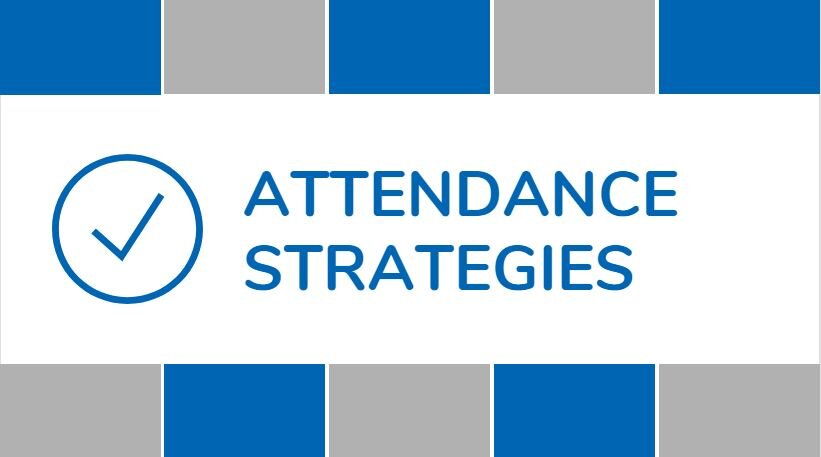Effective Strategies for Improving Attendance and Combating Truancy
The pathway to strong school attendance begins at the end of the previous school year and goes through September. Establishing an attendance plan during this time sets the foundation for the school year and is critical in forming positive habits toward meeting your annual attendance goals.
Set a realistic attendance goal, usually between 2-5% higher than your 3-year average.
Attendance can be a difficult metric to move dramatically in one year, as it often requires a great deal of process and cultural change. The first step in making attendance a priority is setting a realistic goal grounded in historical data. While your school may be striving for a 5% attendance increase, if your school has never had a 5% increase in one school year, it is unlikely that you will hit that target in one year. It is important to anchor your attendance goal to reference points, such as past year improvement or achievements of comparable schools.
Peer performance can be used to discern whether an attendance goal is reasonable. The average attendance of a District of Columbia Tier 1 PK-8 or high school in 2016-17 was roughly 93%. Thus, if a school is currently at 90%, a goal of 95% overshoots average peer performance and may be unrealistic. In this instance, a goal of 93% is more attainable and on par with high performing peer schools.
When a goal is set it should be communicated throughout the organization. Everyone (including, but not limited to parents, students, and Board and community members) should know the annual attendance goal and track performance on a daily, weekly, and monthly basis in relation to the established goal.
Create and enforce a school-wide attendance plan.
Once a goal is established for the year, instructional and administrative leadership should develop a school-wide attendance plan. This plan should include full participation from teaching, support, and administrative/operational staff at the school. Some key questions to consider when creating a plan are as follows:
What time should all students arrive at school to be in compliance with local regulations?
What time should all teachers submit attendance?
Which staff member(s) will review attendance submission to account for tardies and excused absences, and resolve missing or incorrect attendance?
Which staff member(s)/staff group(s) will track chronically absent or truant students?
What interventions are in place to get these students on track? Are these interventions researched and proven to be effective?
Where and how will follow-up efforts be documented?
Are the appropriate forms and public notifications for truant students easily accessible for distribution (i.e. in your SIS)?
How often is this information being reported across the school? Who owns the creation and distribution of attendance data? How is the data cut and displayed (homeroom class, teacher, building, network, etc.)?
Are there weekly/monthly/quarterly meetings on the calendar to discuss progress toward goals and effectiveness of interventions?
Developing an internal attendance document of the full attendance process is important to maintain fidelity and a commitment to achieving the annual goal. Establishing such a plan also sets clear expectations for teachers and staff on their expected roles.
Take and submit attendance EVERY DAY.
Our experience has shown that this step can be quite difficult for schools and teaching staff to follow given teacher workload. As previously suggested, a daily cut-off time should be enforced by administrative and operational staff to set the expectation that attendance must be submitted in a timely manner. The cut-off is typically by or before 10:00 am at most schools.
After the cutoff time, schools will typically either send an email blast to teachers or have an operations staff member correct attendance. Enforcing timely attendance submission and correction at the beginning of the school year builds a strong attendance culture that will lead to more accurate overall and interim attendance rates.
Follow-up communication with parents/guardians.
Once a student is absent, there should be multiple touchpoints to follow-up with their parent/guardian. Often the most effective touchpoint is a follow-up call from the student’s homeroom or primary teacher. Schools have found that designating a homeroom or advisory teacher to contact parent/guardian helps to extend the teacher-student rapport to families and foster a strong family-school relationship.
Schools will often supplement teacher follow-up with an automated messaging system. Platforms such as SchoolMessenger or AlertSolutions can connect to a school’s SIS and trigger a phone call, text, and/or email to a household once a student is marked absent for the day. This kind of solution helps support staff follow-up with families quickly and regularly. Schools should designate an attendance coordinator, dean, or other support staff member to connect with the student and the family to develop an attendance plan that addresses the root cause of their attendance issues. There should be some level of human or automated follow-up to households to reinforce the importance of daily attendance.
Offer attendance incentives.
One of the more effective strategies to improve attendance is offering incentives. Schools have published homeroom attendance rates on a weekly or monthly basis and awarded prizes to high performing and most improved students and classes; these activities may include pizza parties, school dollars, sports tickets, game nights, etc. Incentives help to support investment in the importance of attendance at the student, parent, and teacher levels and continue to reinforce a culture where school attendance is celebrated.
[This post contributed by Breanna Day, New York Data Manager.]

